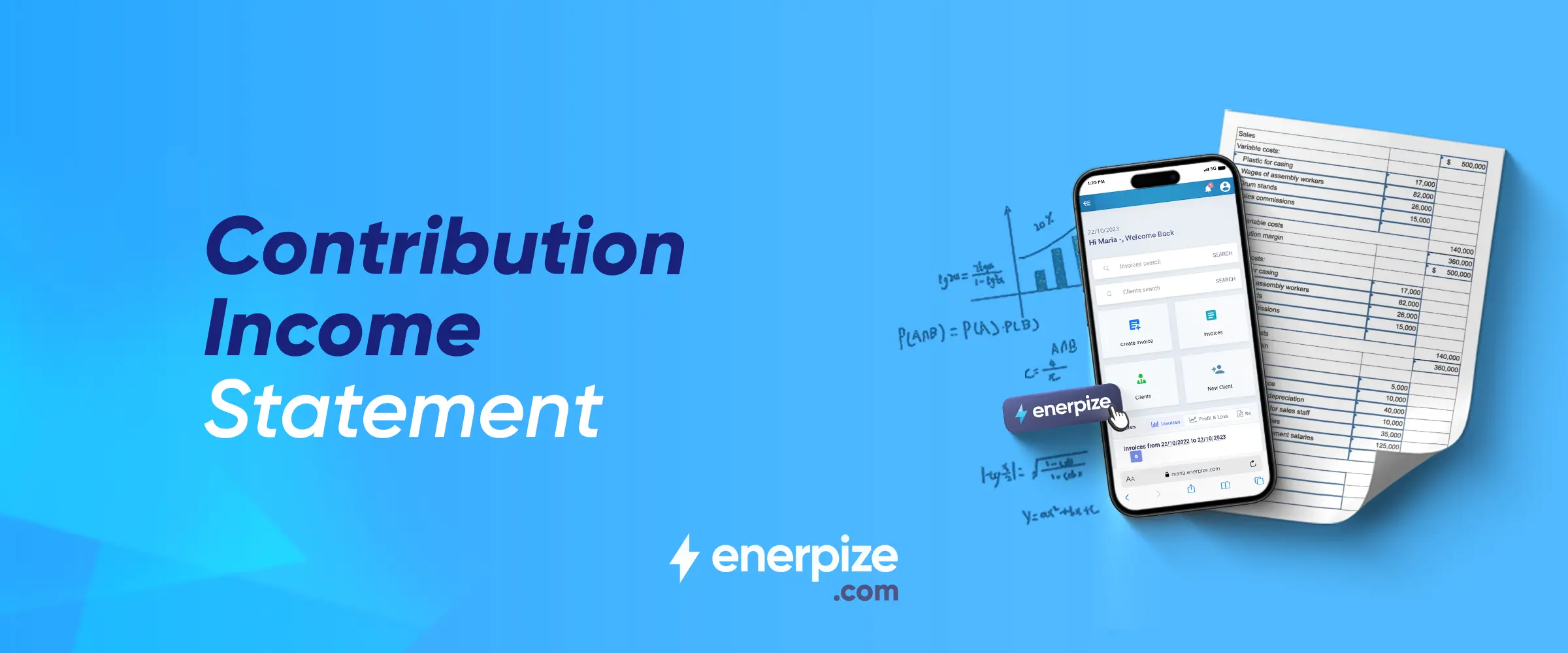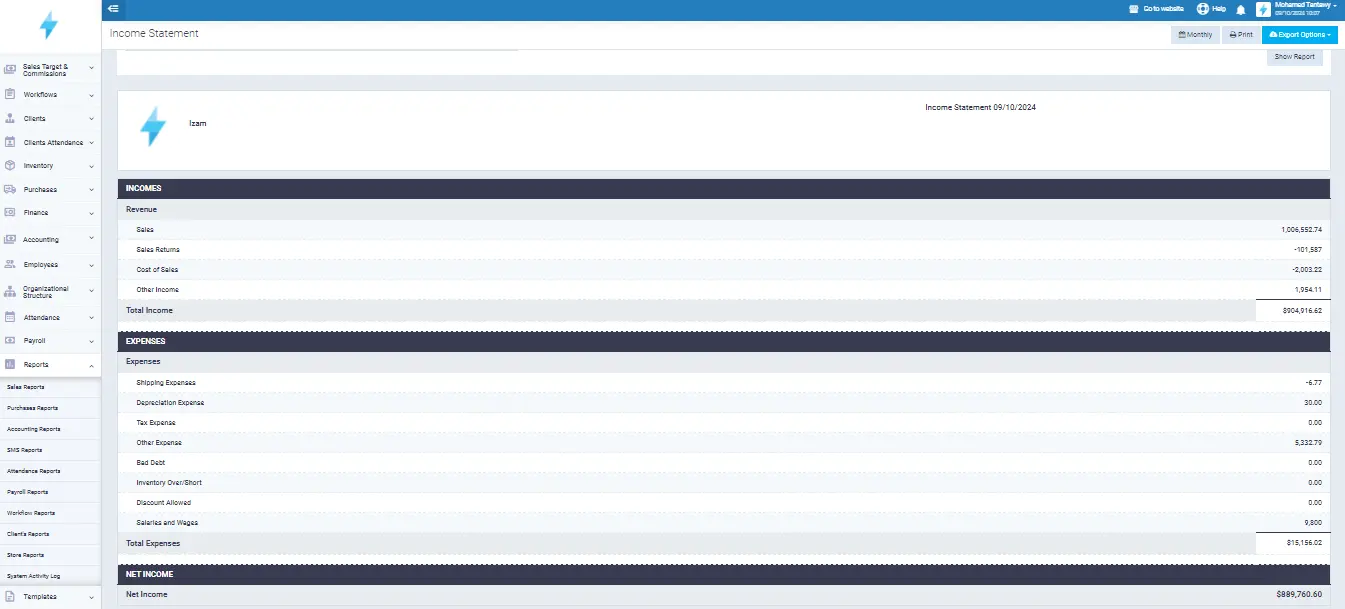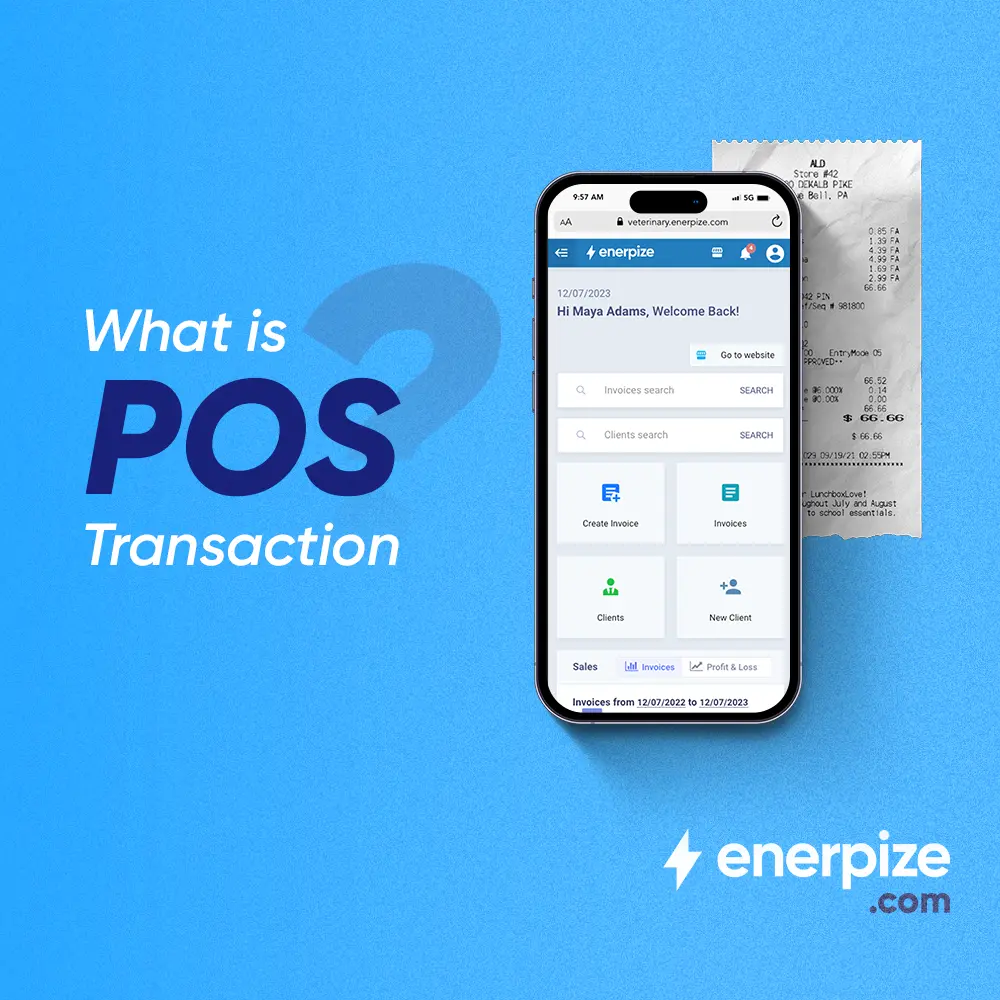Author : Enerpize Team
Contribution Income Statement: A Comprehensive Guide

Table of contents:
Outstanding companies know how to manage profit and loss so they grow. Less calculating companies do not, and so they go bust. That is why managing profits and losses goes beyond crunching numbers or settling accounts.
Instead, managing revenue and expenses is all about diving deeper into sorting out your expenses into fixed and variable ones. Here is where a contribution income statement (aka contribution margin income statement) comes in. The contribution statement controls a company's expenses by separating costs based on variability, allowing managers to decide which products perform well.
Contribution statements differ from and share basic similarities with traditional income statements. Traditional income statements mix and account for fixed and variable costs based on their relationship to production, whereas contribution statements separate costs based on variability alone. Both conclude with only one bottom line: operating income.
To understand what contribution income statements are, why they are super important to savvy managers, and how contribution and traditional income statements compare, read on.
This post is every calculating manager’s go-to guide on contribution income statements.
Key Takeaways
- A contribution income statement separates variable and fixed costs, helping businesses understand how much revenue remains after covering variable expenses, which supports better decision-making.
- Unlike traditional statements, the contribution income statement organizes costs by behavior rather than function, offering clearer insight into how products or services contribute to profitability.
- This format is great for internal use, helping managers analyze cost behavior, adjust pricing, and improve operations without replacing the standard income statement.
- Contribution income statements are especially helpful for break-even analysis, showing how many units must be sold to cover costs, which is key for planning and forecasting.
- Though not used in external reporting, the contribution income statement is a powerful internal tool for tracking product or departmental performance and detecting inefficiencies early.
- Accounting software automates data entry, cost tracking, and reporting, making it easier to create contribution statements and manage finances in real time.
What is the Contribution Margin Income Statement?
As noted, the contribution margin income statement is a statement of a company’s costs or expenses, regardless of whether they are used to produce goods or provide services. Fixed expenses include lease, payroll, insurance, etc. Meanwhile, variable expenses include raw materials, commissions, loan interest, etc.
The contribution margin income statement is also called a contribution income statement or a variable cost income statement. This is because contribution statements, unlike traditional income statements, are used to calculate a company’s contribution margin, which is calculated by subtracting variable costs from revenue. (More about traditional vs contribution income statement in a bit.)
That being said, you may wonder why managers would produce another statement, such as a contribution statement, and have one more accounting burden of coming up with a new revenue vs. expense statement when the income statement is a standard and, unlike contribution statements, reportable to regulatory authorities. Here is why.
Contribution Income Statement Example
| Particulars | Amount ($) |
| Sales Revenue | 100,000 |
| Less: Variable Costs | |
| - Direct Materials | 30,000 |
| - Direct Labor | 20,000 |
| - Variable Manufacturing Overhead | 5,000 |
| - Variable Selling Expenses | 2,000 |
| Total Variable Costs | 57,000 |
| Contribution Margin | 43,000 |
| Less: Fixed Costs | |
| - Fixed Manufacturing Overhead | 10,000 |
| - Fixed Selling and Administrative Expenses | 15,000 |
| Total Fixed Costs | 25,000 |
| Operating Income (Profit) | 18,000 |
The above example shows, in bold, “Sales Revenue,” “Total Variable Costs,” “Contribution Margin,” “Total Fixed Costs,” and “Operating Income (Profit).” The operating income is calculated by:
- Identifying overall Sales Revenue ($100,000).
- Adding up Variable Costs ($57,000).
- Subtracting Variable Costs ($57,000) from Sales Revenue ($100,000) to get Contribution Margin ($43,000).
- Adding up Fixed Costs ($25,000).
- Subtracting Total Fixed Costs ($25,000) from Contribution Margin ($43,000) to get Operating Income ($18,000).
This operating income shows pre-tax profit, a positive signal to investors interested in investing in such a company.
Just like many financial statements and sheets, contribution statements can be created manually (i.e., using conventional paper-based documentation methods) or automatically (i.e., using automated ERP software).
Going automatic involves some complications, not least of which is installation and setup. This is where business owners and executive managers might need some guidance and understanding of which software or cloud-based solutions are the best fit.
Download Now: Free Contribution Margin Income Statement Excel Template
Importance of Contribution Income Statement
As noted, contribution statements serve a different purpose than more traditional income statements. Here is why contribution statements are important (and loved by savvy managers).
Control Costs
Contribution income statements help managers keep a tap on expenses. By separating variable costs from fixed costs, financial planners, controllers, and accountants can identify specific operating patterns where revenue or expenses show unusual performance, up or down.
For example, mill line managers can decide whether to invest in capital equipment to maximize the production of one or more products, reduce or eliminate production in other lines altogether, or switch to whole new product lines. This is a decision at scale and of substantial consequences where cost control is directly related to production, which is directly related to entries in income statements, although not stated in contribution statements.
Read Also: Prepaid Expense Journal Entries: Importance, Examples & How to Record?
Perform Break-Even Analysis
Importantly, contribution statements can be used to perform break-even analysis. Companies—particularly startups—need to know at which point a given product, segment, subsidiary, or even the company as a whole would profit after pouring money into business activities for short or long periods.
For startups, a break-even analysis is a make-or-break situation. Generating profits faster at lower operating and non-operating costs distinguishes wise, fast-growth companies from comparable companies that burn cash without much consideration for bottom lines.
Download Now: Free Break Even Analysis Template
The bottom line is, having a contribution income statement pays.
Differences Between Contribution Income Statement and Traditional Income Statement
The traditional vs contribution income statement merits your particular attention as a business owner or executive manager. Here are four main differences between contribution and traditional income statements.
1- Cost Accounting
One significant difference between contribution and traditional income statements is how each is calculated expense-wise to arrive at an ultimate operating income line.
Contribution statements record all fixed and variable costs separately, e.g., based on variability only. Meanwhile, traditional statements record all expenses related to production and management, i.e., based on whether an expense is related to production or management costs, regardless of variability.
An additional benefit of using contribution statements may be using two different approaches to calculate a company’s operating income. Reconciling financial records is essential in cost accounting. By double-checking accounts to individual entries, controllers and auditors ensure all records and calculations are mathematically correct. Since contribution statements are only used internally, as explained in a bit, having such additional statements serves as early auditing systems akin to early warning systems used to alert responders to potential dangers and to act accordingly preemptively.
Read Also: Journal Entries for Bank Reconciliation: A Comprehensive Guide
2- Different Margins
The margins calculated for contribution and income statements are also different. Traditional income statements calculate a company’s gross profit margin by subtracting the cost of goods sold COGS from revenue. Meanwhile, contribution margins are calculated by subtracting variable costs from revenue. Variable costs are only a subset of COGS, usually including fixed and variable costs.
This difference in margin calculation is a case in point. Specifically, while gross profit margins are important for a more general overview of how a given company generates revenue and incurs expenses, contribution margins provide a more granular and dynamic view of how costs are incurred to meet different operational needs over a short span.
Read Also: How to Calculate Cost of Goods Sold: Formula & Examples
3- General vs. Specific
Traditional and contribution statements also differ along a critical criterion: generality. That is, while traditional statements are, by definition, more general, accounting for a given company’s overall profitability over a given reporting period, contribution statements are granular, accounting for a more detailed account of variable and fixed costs.
The level of detail in contribution statements is a holy grail for savvy managers who want to closely examine cost dynamics on a daily basis to adjust as quickly as possible for any needed changes in sales operations, pricing, or production.
For example, assume a textile mill floor manager wants to dive deeper into how the cost of one or a group of input materials (say, weaved cotton) is affecting the mill’s overall cost to decide whether to source waived cotton from a different supplier, rely less on cotton-based products, or switch to more innovative textile solutions. This understanding of cost sets contribution statements from traditional income statements, where a manager focuses more on overall profitability, not per-product cost per see.
4- Internal vs. External Application
As noted, where contribution statements are used only internally, traditional income statements are more formal and reportable to relevant regulatory authorities.
The benefit of each, in terms of use, is substantial. Used internally, contribution statements act as miniature income statements, based on which planners, controllers, and auditors can identify short-term cost patterns. Traditional income statements, however, are geared for external users - such as external auditors, regulatory authorities, and public oversight - where statement format and content are particularly important to be accepted as formal financial statements.
This difference in application is similar to cost accounting in one important way. Specifically, contribution statements—used internally only—act as an early warning system for all involved financial planners, controllers, and auditors. So, like in cost accounting, contribution statements represent invaluable accounting information at a more granular level where internal stakeholders can adjust and reconcile accounts early on before going formal in traditional income statements.
How Can You Use Enerpize in Contribution Income Statement?
Using Enerpize to generate accurate and compliant contribution statements is guaranteed to businesses looking for a leading, cost-effective, and accounting operations management solution.
To get a sense of what Enerpize can offer to help with contribution income statement and more, here are only a few features and benefits:
- Track and manage your earnings and spend any time, anywhere.
- Show a snapshot view of all revenue, expenses, and net income.
- Choose how to calculate income from invoices within preset date ranges and get accurate net profit calculations.
- Define tax brackets and classes (e.g., GST, VAT, EXP, etc.) based on monthly, quarterly, and annual reporting requirements.
- Use Enerpize’s customizable cost centers to monitor operating expenses, control overall spending, and calculate profitability per product or department.
- Use Enerpize’s comprehensive and automated Chart of Accounts to list identified accounts and record transactions in your general ledger.
- Maintain a record of all transactions over your company’s life and always get accurate and comprehensive financial statements and reports whenever you need them for internal or external use.
- Categorize expenses, vendors, and customers per group, tier, payment range, and more.
- Set your currency and tax requirements as and when needed for internal control and external regulatory purposes.
- Speed up customer payments with Enerpize’s dedicated customer portal.
- Enable various payment options to help speed up customer payments with certain payment restrictions in some jurisdictions.
- Dynamically set commission structures to manage commission payments for your sales teams.
- Create customizable offers for your loyal and prospective customers for enhanced revenue and for possible upsell opportunities.
- Create customizable estimates and quotes for more expedited sales and customer satisfaction.
These features and benefits will set your company apart from the competition. Invest wisely in Enerpize as your accounting management solution.
Enerpize is primarily an online accounting software for businesses with varying and evolving needs. As such, Enterprise is best positioned to cater to ever-changing business needs, particularly cost structuring in response to market dynamics.
Try us 14 days for free, and start reaping the expected and unexpected rewards and benefits and leaving behind all your accounting concerns.

Final Thoughts
Contribution income statements are often overlooked as important financial statements for managing costs and planning for business growth. Used by savvy business owners and executive managers, contribution statements provide insights not obtainable elsewhere in accounting management’s repertoire of financial statements, sheets, and reports.
Contribution statements, which include a full record of all variable and fixed costs, help business owners and executive managers control costs and perform break-even analysis, both of which are critical in production operations planning and demand forecasting.
Traditional and contribution statements differ in four important areas:
- Cost Accounting. Both arrive at an ultimate operating income line. However, whereas traditional statements calculate all expenses related to production and management, contribution statements calculate fixed and variable costs based on availability alone.
- Different Margins. Where traditional statements calculate a company’s gross profit margin (Revenue - COGS), contribution statements calculate contribution margins (Revenue - Variable Costs).
- General vs. Specific. Where traditional statements account for a company’s overall profitability, contribution statements are cost-specific and limited to accounting for fixed and variable costs to calculate a company’s contribution margin.
- Internal vs. External Application. Where contribution statements are intended for internal use only, traditional income statements are, by definition, intended for external auditing and regulatory purposes.
Contribution statements can be created manually or automatically.
Choosing what suits your business best to manage your accounting operations, including creating contribution statements, boils down to your needs and market dynamics. Make no mistake opting for your best-fit accounting software.
Contribution income statements are easy with Enerpize.
Try our accounting module to create financial statements easily.








